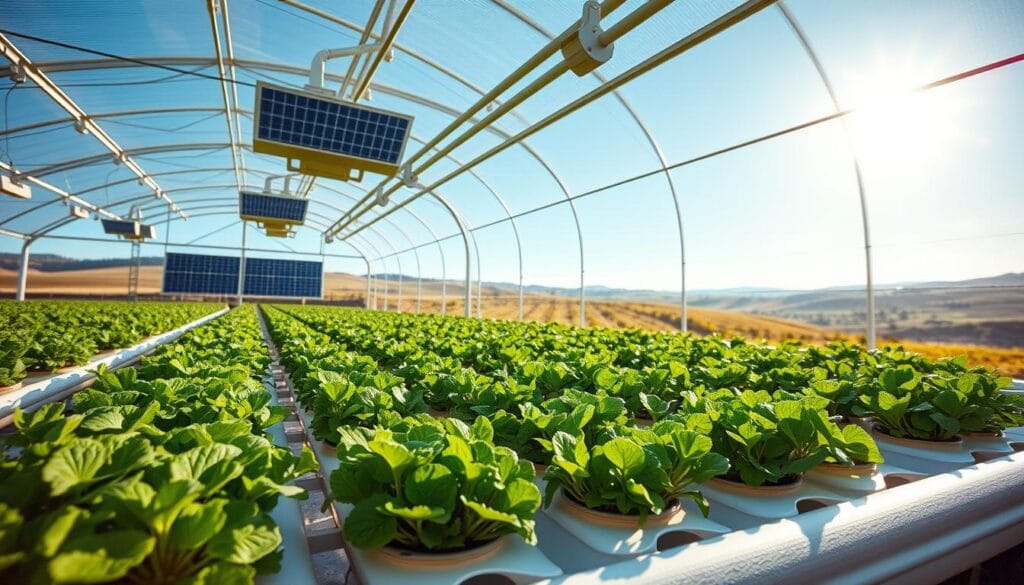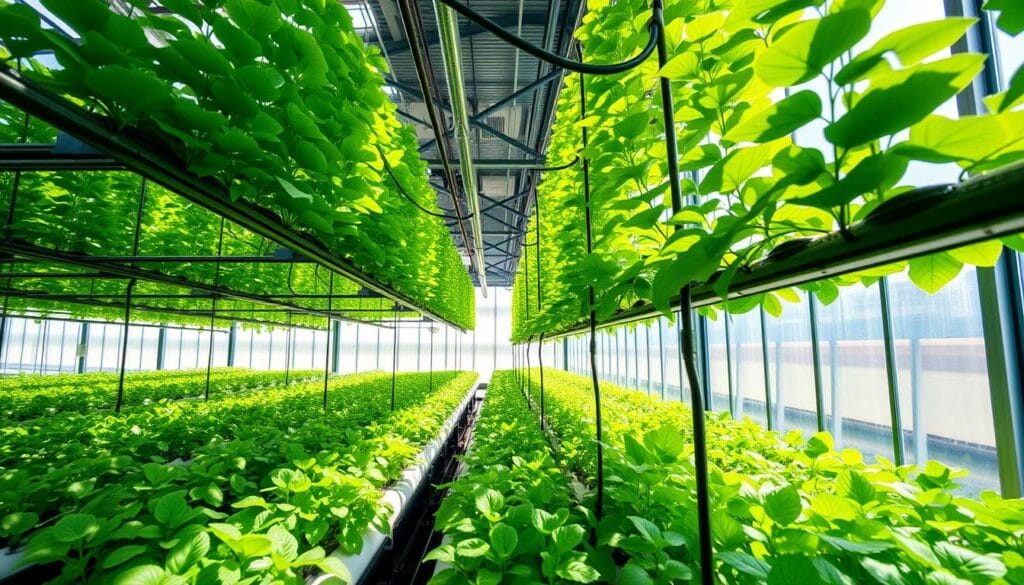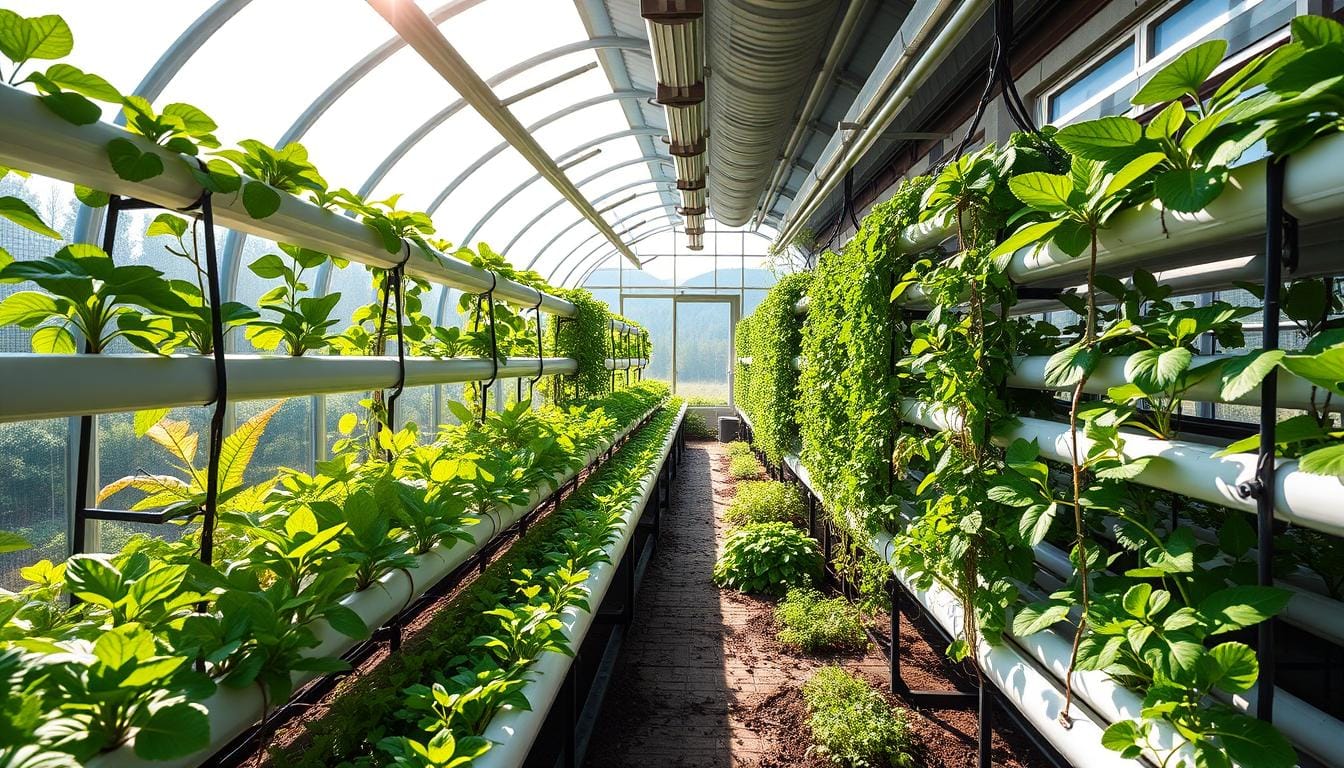“The Environmental Impacts of Hydroponic Farming: A Game-Changer for Sustainable Agriculture”
Standing among the lush, green plants, I was amazed by hydroponic farming’s power. The environmental impacts of hydroponic farming are profound, offering a soil-less method of growing food that addresses many of the challenges traditional farming faces. From water conservation to reduced land use and lower carbon emissions, hydroponic farming is reshaping agriculture in a more sustainable direction. Let’s dive into the five main ways hydroponic farming impacts the environment, making it a key player in our green future.
Key Takeaways
- Hydroponic farming can cut water usage by as much as 90% when compared to conventional farming techniques, offering a more efficient and eco-friendly solution.
- Hydroponic systems can increase crop yields by up to 50% while using less space.
- Hydroponics can significantly lower greenhouse gas emissions and carbon footprint.
- Hydroponic farming minimizes the use of pesticides and herbicides, promoting healthier food production.
- Hydroponic systems can help address land degradation and soil-borne diseases, ensuring long-term sustainability.
Understanding Modern Agricultural Challenges
The world’s population is growing fast, making food production more critical than ever. Yet, traditional farming is facing harsh criticism for its environmental harm. Issues like greenhouse gas emissions, soil degradation, and water pollution highlight the urgent need for sustainable farming solutions.
Current State of Traditional Farming
Old farming ways, like monoculture and heavy chemical use, harm the environment. Agriculture is responsible for nearly 24% of global greenhouse gas emissions, fueling climate change. Also, traditional farming uses 70% of the world’s freshwater, causing water scarcity and pollution.
Environmental Pressures on Agriculture
Soil degradation, caused by erosion and chemical misuse, is a big problem. This threat to soil health puts food security and biodiversity at risk. Climate change makes these issues worse, affecting crop yields and farm resilience.
Need for Sustainable Solutions
The rise of sustainable agriculture is a response to these environmental worries. It seeks to cut down on chemicals, protect biodiversity, and enhance soil health. Sustainable farming methods, like crop rotation and precision farming, help reduce environmental harm. They ensure a greener, more sustainable food future.
Introduction to Hydroponic Farming Systems
Hydroponic farming is an innovative method of cultivating plants without the need for soil. Hydroponic farming offers a modern approach to growing plants without using soil. This method is better for the environment and saves resources.
Hydroponic systems help plants grow better and faster. They use less water and resources. There are many types, like NFT, DWC, and Drip Systems. Each one is good for different plants and growing conditions.
Hydroponic farming uses much less water than old farming ways. For example, Hydroponic farming requires 98% less water compared to traditional farming methods. In California, schools grow lettuce using hydroponics. This helps save water and is good for the environment.
Hydroponic farming is not just about saving water. Cultivate program in Wisconsin trains high school students to run a hydroponic farm. This creates jobs and teaches important skills. In Milwaukee, a grocery store gets fresh produce from these students. This helps people in the area get healthy food.
Many places are starting to use hydroponic systems. Marshfield Community Health System in Wisconsin has set up over 40 hydroponic farms. They give fresh produce to schools and food banks. This helps people eat better and stay healthy.
| Hydroponic Farming Benefits | Statistics |
|---|---|
| Water Conservation | Hydroponic farming uses up to 90% less water compared to traditional agriculture. |
| Plant Growth | Plants in hydroponic systems grow 25-30% faster due to direct access to nutrients. |
| Space Efficiency | Hydroponics enables space efficiency through vertical systems, maximizing farming in urban settings. |
| Crop Yields | Hydroponics leads to increased crop yields due to better control over growing conditions. |
Hydroponic farming is changing how we grow food. It helps communities grow food even in tough places. Places like Fork Farms use hydroponics to feed people who don’t have access to fresh food. Schools and universities teach about hydroponics to help with sustainable farming.
Hydroponics is not just for growing food. Hospitals grow fresh produce for patients. Zoos and aquariums use it to feed animals and help endangered plants. As we want more sustainable farming, hydroponics will play a big role.
Water Conservation and Management in Hydroponics
Hydroponic farming systems are known for saving a lot of water. They use a closed-loop water system, which cuts down on water waste. This method can save up to 90% less water than traditional farming.
Keeping the water quality right is key in hydroponics. It helps plants get the nutrients they need. The best pH for plants is between 5.5 to 6.5. Growers also adjust the nutrient solution’s electrical conductivity (EC) to match the plants’ growth stages.
Closed-Loop Water Systems
Hydroponics use closed-loop water systems. This means the water is constantly recycled and reused. It’s much better for water conservation than traditional farming, which loses a lot of water.
Reduced Water Consumption Statistics
Hydroponics is very water-efficient. For example, small plants need about 0.5 gallons of water each. Medium plants need 1.5 gallons, and big plants need 2.5 gallons. In contrast, cannabis plants in soil can use up to 1-3 gallons of water a day.
Water Quality Maintenance
Keeping the water quality right is crucial in hydroponics. Growers check and adjust pH, electrical conductivity, and oxygen levels. This ensures plants get the right nutrients and grow well. New technologies like sensors and AI help automate this process for better results.
Hydroponics helps a lot with water conservation, sustainable agriculture, and efficient use of resources. It saves water and lets growers control nutrients better. This leads to better crop yields and a greener future.
Space Optimization and Land Use Benefits
The growth of urban farming and sustainable agriculture has sparked interest in efficient farming. Hydroponic farming is a key solution, offering big benefits in space use and land efficiency.
Hydroponic systems can grow more crops in smaller areas because they are designed vertically. This approach cuts down on the need for large land areas and helps protect natural habitats. It also allows for growing food all year, perfect for cities and local food needs.
| Key Efficiency Metrics | Conventional Farming | Hydroponic Farming |
|---|---|---|
| Land Use | Requires extensive land | Utilizes vertical space, minimizing land footprint |
| Water Consumption | High water usage | Up to 90% less water consumption |
| Harvest Cycle | Seasonal, dependent on climate | Year-round production, controlled environment |
| Labor Costs | Higher labor requirements | Approximately 30% lower labor costs |
The data clearly shows hydroponic farming’s benefits in space, water, and year-round food production. By adopting these new farming methods, we can move towards a more sustainable and efficient future in urban farming and sustainable agriculture.
“Hydroponic farming allows us to grow more food in less space, using significantly less water and resources. This is a game-changer for urban farming and ensuring food security in a changing climate.”
Environmental Impacts of Hydroponic Farming: Analysis and Benefits
Hydroponic farming is a game-changer for a greener future. It uses controlled environments and precise resource management. This makes hydroponic systems stand out from traditional farming.
Reduced Carbon Footprint
Hydroponic farming has a big advantage: it’s much better for the planet. It requires less land and generates lower emissions.This means hydroponic farming can cut carbon footprint by up to 50% compared to old-school farming.
Minimized Chemical Usage
Hydroponic farming doesn’t need harsh chemicals. It uses a precise nutrient system for plant growth. This way, growers can produce organic produce that’s good for the environment and people’s health.
Resource Efficiency Metrics
Hydroponic systems are super efficient with water and energy. They can use up to 90% less water than traditional farming. This is key for areas with water shortages. Plus, they use energy-efficient tech, cutting down energy use even more.
Hydroponic systems are a sustainable answer to old farming problems. They have a smaller carbon footprint, use fewer chemicals, and are more resource-efficient. This makes hydroponic farming a promising way to make farming greener and more sustainable.
Energy Consumption in Hydroponic Systems
Energy use is key in sustainable farming. Hydroponic systems need power for lights, pumps, and climate control. But, new LED tech and green energy are making them more efficient.
A small hydroponic setup uses 200 to 500 watts daily. Bigger ones might need up to 1500 watts or more. Old HID lights used a lot of energy, but LEDs are changing that.
LEDs cut down energy use in hydroponics. This means big savings and less greenhouse gas emissions. Keeping systems well-maintained and using timers for lights also helps save energy.
Hydroponics has many advantages. It can grow crops 50% faster than traditional farming. And it uses only 10% of the water needed in regular farming.
Methods like NFT, aeroponics, wicking, and drip systems make hydroponics even better. They help plants grow well and use resources wisely. This way, we can make farming more sustainable and better for our planet.

Soil Conservation and Protection
Hydroponics is a new way to farm that doesn’t need soil. It’s a big help for soil conservation and green farming. This method keeps natural soil healthy and stops soil degradation from old farming ways.
Prevention of Soil Degradation
Hydroponics is great because it grows crops without soil. This new method saves soil and fights soil degradation. It avoids soil damage by not using tilling, chemicals, and other harmful activities.
Eliminating Soil-Based Diseases
Hydroponics also stops soil-based diseases. It grows crops in a clean, soil-free space. This cuts down on soil diseases and pests, making farming safer and greener.
Using hydroponics is a big step for our soil’s future. It moves away from old soil farming and leads to soil conservation. It also helps grow organic produce that’s good for us and the Earth.
Urban Agriculture and Local Food Production
Hydroponic farming is changing how we grow food in cities. It’s perfect for city spaces, making local food and cutting down on carbon emissions. By using rooftops and warehouses, urban hydroponic farms turn empty areas into green spaces. This helps make our food systems more sustainable and strong.
One big plus of urban farming with hydroponics is saving space. These systems grow food all year, making the most of small city areas. They also use much less water than regular farming, by recycling nutrients.
By combining hydroponic farming and urban agriculture, we get more food security and jobs. Local food systems mean we always have fresh produce, cutting down on transport emissions.
| Benefit | Impact |
|---|---|
| Space Efficiency | Maximizes year-round production in limited urban spaces |
| Water Conservation | Reduces water usage through recycling and reuse of nutrient solutions |
| Food Security | Enhances access to fresh, locally-grown produce in urban areas |
| Sustainable Agriculture | Minimizes the carbon footprint associated with food distribution |
Starting up with hydroponic farming can be tough, needing money and tech know-how. But the long-term gains for urban agriculture and sustainable local food production are clear. As cities face food and environmental challenges, hydroponics offer a key solution.
Waste Reduction and Management
Hydroponic farming is great for reducing waste and using resources wisely. It uses closed-loop systems to recycle nutrient solutions. This reduces waste and benefits the environment. It also saves resources and fits with sustainable agriculture.
Nutrient Solution Recycling
Hydroponic systems are good at recycling nutrient solutions. Instead of throwing away used solutions, they are reused. This saves resources and makes sure plants get the nutrients they need.
Packaging and Distribution Impact
Hydroponic farming is local, which helps reduce packaging and transportation waste. Growing food close to where it’s eaten cuts down on long trips and packaging. This lowers carbon emissions and supports waste management and sustainable agriculture.
| Metric | Traditional Farming | Hydroponic Farming |
|---|---|---|
| Water Consumption | High | Low |
| Nutrient Recycling | Limited | Extensive |
| Packaging and Distribution | Extensive | Minimal |
Hydroponic farming follows waste management, sustainable agriculture, and resource efficiency. It shows how we can change food production and distribution for a greener future.

Climate Change Resilience Through Hydroponics
Hydroponic farming is a green solution for climate change. It keeps food production steady, no matter the weather. This is key as weather patterns change, helping communities around the world.
Hydroponics is very water-efficient. It uses only 10% of the water needed for traditional farming. This saves water and helps with droughts caused by climate change.
Hydroponics also has a lower carbon footprint than regular farming. It needs less land and no soil preparation. This helps fight climate change. Plus, it grows plants with fewer chemicals.
Hydroponics is key for a sustainable agriculture and resource efficient future. It boosts climate change resilience and keeps food safe. It also protects our natural resources for future generations.
“Hydroponic systems use 98% less water and land compared to traditional farming methods, making them a vital tool in our fight against climate change.”
Hydroponic farming is a bright spot in the fight against climate change. It helps us grow food sustainably. This way, we can keep our food supplies safe, save resources, and protect our planet.
Future Prospects and Technological Advancements
The world of sustainable agriculture is changing fast, with hydroponic farming leading the way. The future looks bright for hydroponics, thanks to new technologies. These advancements promise better efficiency, more food, and less harm to the environment.
Artificial intelligence (AI) and Internet of Things (IoT) devices are changing hydroponics. AI helps control nutrients, watches plants grow, and adjusts conditions with great accuracy. This makes farming more efficient and ensures better crops.
Using renewable energy is another big step forward. Hydroponic farms can now run on solar, wind, or geothermal power. This makes them eco-friendly and self-sufficient, fitting perfectly with the need for sustainable agriculture and urban farming.
In the future, we might see smaller, easier-to-use hydroponic systems. These “farm-in-a-box” setups will let people and communities grow their own food. This will help us be more self-sufficient and cut down on environmental harm.
“Hydroponics is not just a trend – it’s a transformative approach to food production that holds the key to a more sustainable and resilient future.”
As hydroponics grows, we’ll see even more new technologies and solutions. The future of sustainable agriculture looks bright, with hydroponics at the forefront. It’s leading us towards a greener, more efficient, and self-reliant food system.
Conclusion
Hydroponic farming is a strong, green solution to our planet’s environmental problems. It saves water, uses land wisely, and cuts down on carbon emissions. This shows how hydroponics can change the way we grow food in the future.
The advantages of hydroponics are clear. It can grow more food with less resources and is better at fighting climate change. As technology gets better and more people learn about it, hydroponics will be key in making our food system better and stronger.
Choosing hydroponic farming can help solve big issues like soil loss, water shortages, and the need for greener food ways. By supporting and using these new farming methods, you help keep our planet healthy. This way, we can ensure a rich and lasting harvest for all future generations.

